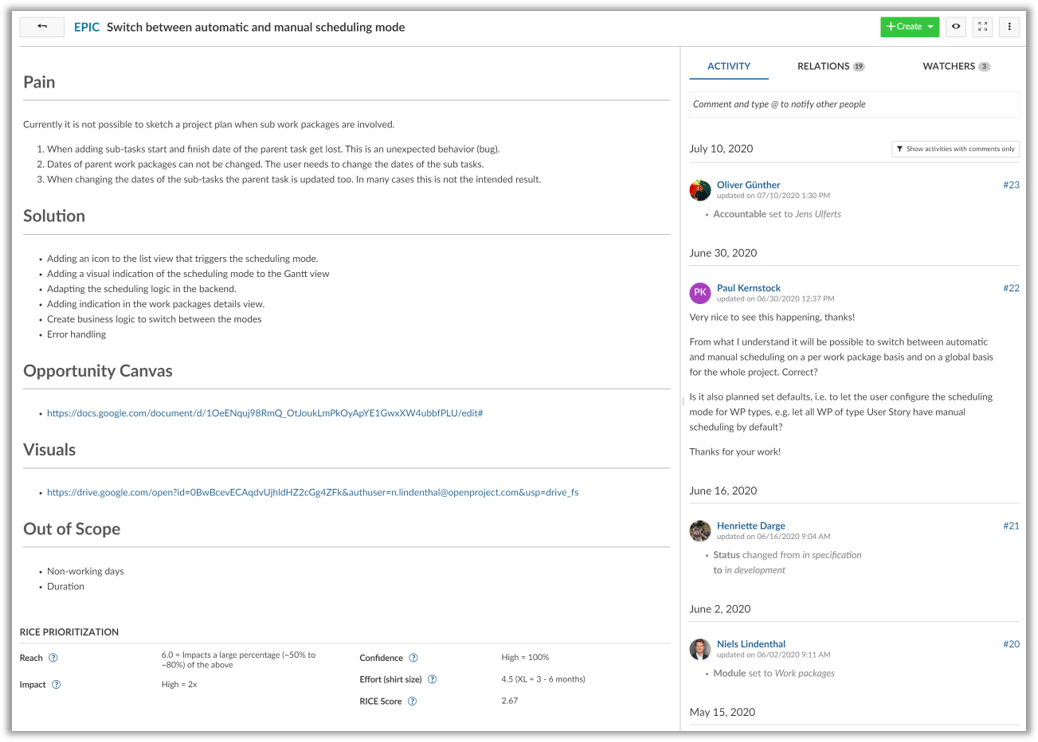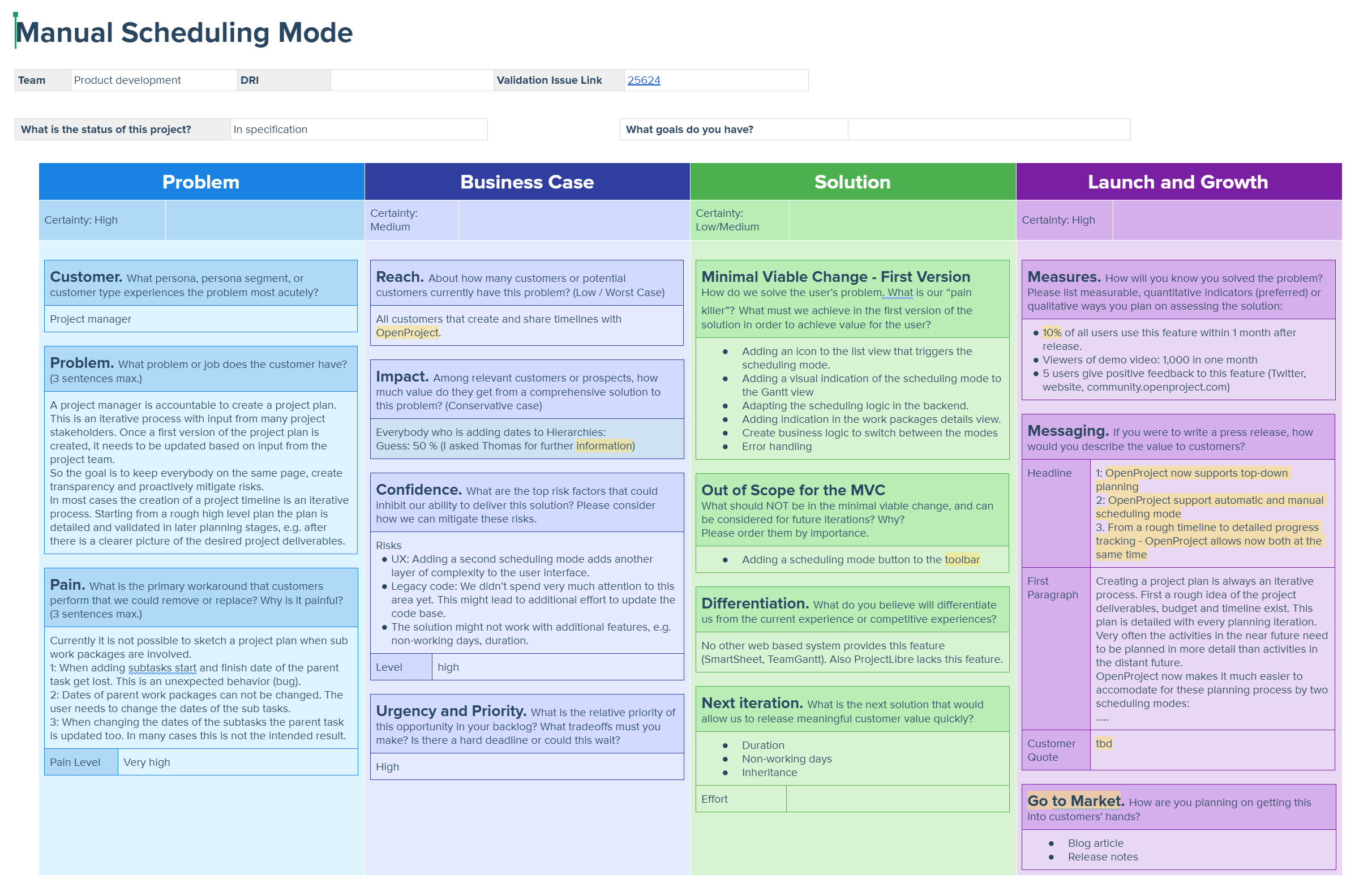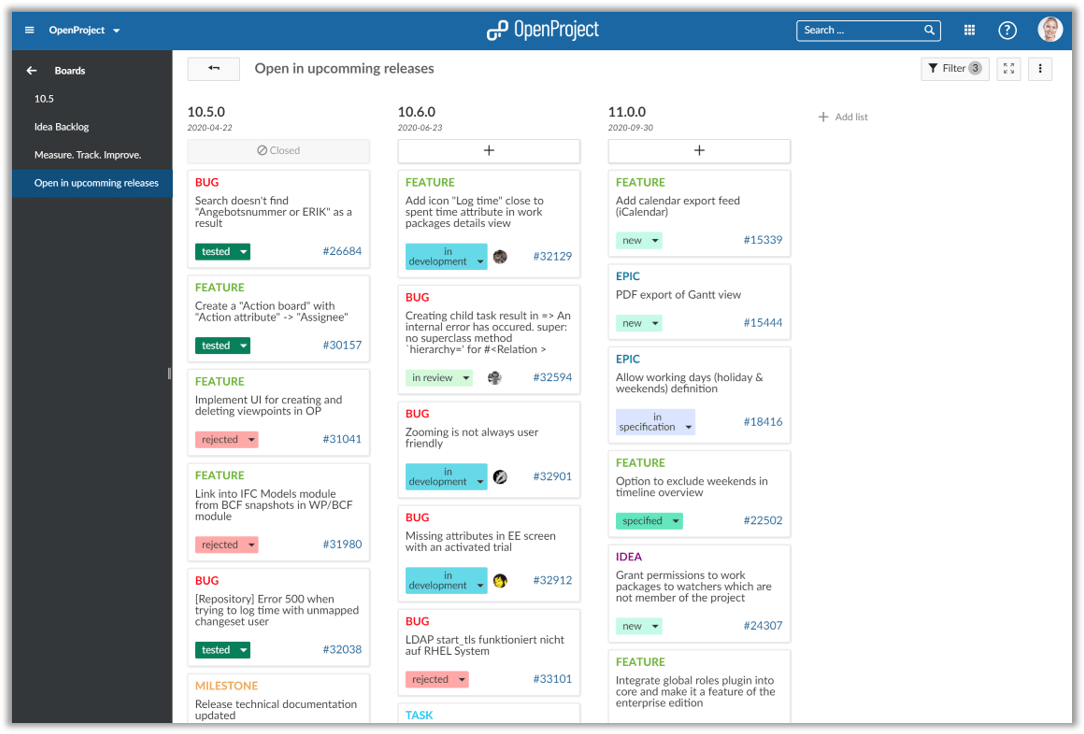Digital product development in times of New Work
What does an innovative product of tomorrow look like? Which user problems should be solved? What will be implemented to solve these problems and how can a digital product development process tailored to these problems be established?
New ways of working in today’s society in the global and digital age mean that products and their development must also be adapted accordingly. It is important to understand exactly which customer needs are at the center of attention in order to develop innovative products. Due to new and flexible working models as well as changing user needs, OpenProject faces the challenge of adapting the product development process to these new conditions. In a project, we at OpenProject have now optimized and standardized our product development process. A process for recording, prioritizing and implementing new product requirements was be established in the company. In particular, customer and user needs are to be given greater consideration and a better collaborative prioritization. A new evaluation and prioritization mechanism is to be developed based on a system of key figures for new requirements, which is also transparent and comprehensible for the community.
Challenges in product development
Distributed teams are now becoming part of the everyday work of many companies. Accelerated by the pandemic triggered by SARS-CoV-2, companies now have to rely on new forms of collaboration and communication in a rapidly changing environment. OpenProject wants to support teams in their work independent of time and location. Due to the huge competition for project management solutions, OpenProject needs to continuously implement innovative product ideas. In order to better understand the requirements for a collaborative project management platform and to better incorporate and implement user and customer needs, a new product development process should be adapted to these circumstances, better structured and documented, and implemented in the company.
Supported by the “unternehmensWert:Mensch plus” program, a new product development process was designed and implemented in times of New Work together with employees from the management, product development, marketing, sales and development departments from OpenProject. After an initial phase of as-is analysis, the focus was placed on the phase of requirements analysis, specification and prioritization, as this is where the greatest potential for optimization was identified. Based on new working conditions, the customer needs for the product should be the focus of attention. The product development process of GitLab served as a model and blueprint for this concept.

Identification of the focus topics through qualitative and quantitative user surveys
Central core topics are to be identified and prioritized at an early stage through direct user and customer feedback. Various tools, such as personal surveys, interviews, but also technically supported bots are used to identify focus topics. Also, we receive many comments and tickets from the community which will be evaluated and rated for implementation.
Making product requirements measurable
The key areas of innovation identified in this way are then documented in a so-called “wishlist”. The product manager analyzes these new requirements and moves them to a “product backlog”. First, the product manager evaluates and assesses the new requirements based on the following criteria:
- Reach
- Impact
- Confidence
- Effort
A RICE value is calculated as follows: RICE value= Reach x Impact x Confidence / Effort
This value can now be used to decide as objectively as possible which new features or improvements should be given particularly high priority on the roadmap. Using the RICE model has three major advantages:
- The product manager is enabled to make better decisions.
- Personal bias in decision making is minimized.
- Priorities can be better argued to other interest groups such as managers, customers or the community.

For a detailed description of the individual values, see our documentation.
Creating an opportunity canvas
For requirements with a particularly high Rice value, the product manager subsequently creates an opportunity canvas. The requirement is described in detail using the following criteria:
- Problem: Here the concrete user problem is described and supported by expert interviews.
- Business Case: The business case is closely related to the RICE value and includes the values Reach, Impact and Confidence to get a measurable value for the new requirement. In addition, the Urgency and Priority section contains information about the relative importance of the requirement compared to other time-related conditions.
- Solution: This section describes the solution of the problem, especially the definition of the “Minimal Viable Change” of a first release as well as what “Out of scope” is and what will not be implemented for the time being.
- Launch and growth: In order to get a complete picture of the requirement and its effects, it is important to consider your marketing message early on. At this point it is defined how to measure whether the problem has been solved. In addition, a marketing message can be formulated directly to identify the value proposition as early as possible. Finally, the go-to-market strategy is formulated.

Digital product management: collaboration independent of time and place
OpenProject as a project management software is used for the collection, administration and documentation of the requirements and all other tasks. The web-based open source software is suitable for both classic and agile project management and team collaboration and supports digital product management as well as roadmap planning. Teams can collaborate across locations and manage their project results there. We have a digital product backlog to prioritize requirements according to their RICE value. Every employee can see directly what will be implemented and can use the platform to clarify queries directly. For the later development phase, Agile Boards can be created for the implementation phase.

Effects of digital product development
The new approach adapts product development to modern working environments. More and more, project management and collaboration take place in distributed teams and is independent of time and location. User requirements are rapidly changing and following these new circumstances. Therefore, processes and methodologies must be created to understand and absorb these new requirements and to design and implement innovative product solutions. Through this new and innovative product development process, OpenProject responds to these new requirements in a flexible and user-oriented manner. This has a direct effect on the quality of the implemented product requirements and the resulting user satisfaction with the product. And finally, we ourselves also work with OpenProject and therefore strive to continuously improve the product.
Enlaces



